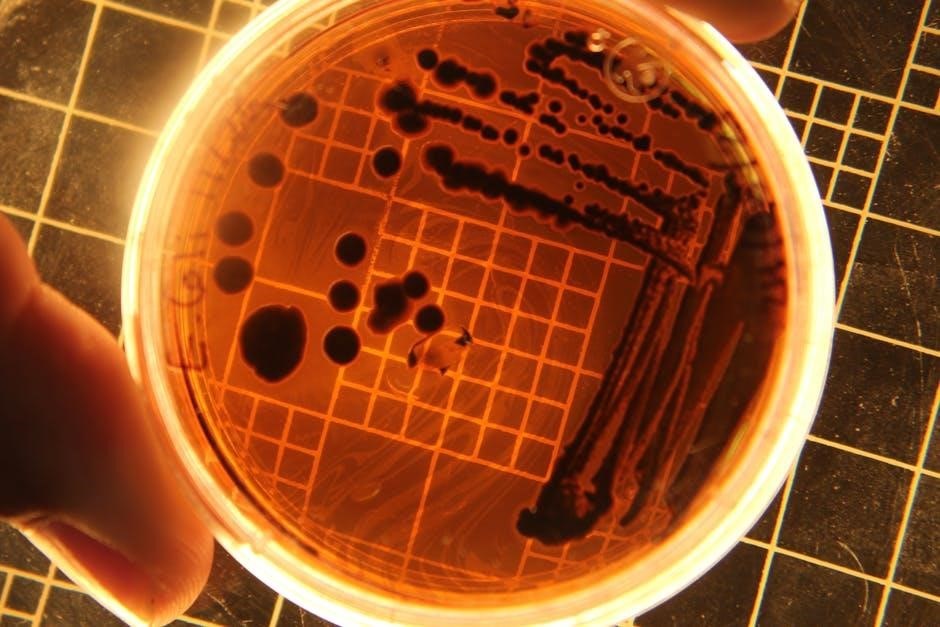Cell biology, also known as cellular biology, is the scientific study of cells, the fundamental units of life․ It explores their structure, function, and behavior, focusing on how cells contribute to the overall function of organisms․ This field is essential for understanding life processes, disease mechanisms, and developing treatments․ By examining cells, researchers gain insights into the molecular and cellular basis of health and disease, driving advancements in medicine, biotechnology, and beyond․
1․1 Definition and Scope of Cell Biology
Cell biology, also known as cellular biology, is the scientific study of cells, the fundamental units of life․ It examines the structure, function, and behavior of cells, including their growth, division, and interaction with their environment․ The scope of cell biology encompasses both prokaryotic and eukaryotic cells, exploring their anatomy, metabolism, and signaling mechanisms․ This field integrates biochemistry, genetics, and molecular biology to understand cellular processes․ By studying cells, researchers uncover the principles underlying life, disease, and development․ The scope extends from basic research to practical applications in medicine, biotechnology, and beyond, making it a cornerstone of modern biological science․
1․2 Historical Overview of Cell Biology
Cell biology traces its origins to the 17th century with the invention of the microscope, enabling scientists like Robert Hooke to observe cells․ The term “cell” was coined by Hooke in 1665․ In the 19th century, Matthias Schleiden and Theodor Schwann proposed the cell theory, establishing cells as life’s fundamental units․ Later, advancements in microscopy and molecular biology expanded understanding of cellular processes․ Key milestones include the discovery of cell division, organelle functions, and molecular mechanisms․ Modern techniques like single-cell RNA sequencing and spatial biology continue to revolutionize the field, building on centuries of exploration and discovery in cellular biology․
1․3 Importance of Cell Biology in Modern Science
Cell biology is cornerstone of modern science, driving advancements in medicine, biotechnology, and agriculture․ It provides insights into cellular mechanisms, enabling the development of treatments for diseases like cancer and genetic disorders․ Understanding cell signaling, metabolism, and division aids in drug discovery and regenerative medicine․ Advances in cellular biology have led to breakthroughs in stem cell therapy, gene editing, and personalized medicine․ Additionally, it informs environmental science by studying cellular responses to pollutants․ The field’s contributions are vast, making it indispensable for addressing global health challenges, improving crop yields, and understanding life at its most fundamental level, impacting virtually every aspect of scientific research and application․

Structure of Cells
Structure of cells refers to the organization of cellular components, including the cell membrane, organelles like the nucleus and mitochondria, and the cytoskeleton, which together maintain cellular function and integrity․
2․1 Cell Membranes and Their Functions
The cell membrane is a thin, semi-permeable lipid bilayer surrounding the cell, regulating the movement of materials in and out․ It controls the flow of ions, nutrients, and waste, maintaining cellular homeostasis․ This membrane also facilitates communication through signaling molecules and receptors, enabling cells to respond to external stimuli․ Additionally, it helps maintain the cell’s shape and internal environment․ Its selective permeability ensures essential substances enter while harmful ones are kept out, playing a critical role in cellular survival and function․
2․2 Organelles and Their Roles
Organelles are specialized structures within cells, each performing unique functions essential for cellular survival and activity․ The nucleus houses genetic material, regulating cell growth and reproduction․ Mitochondria generate energy through ATP production, powering cellular processes․ The endoplasmic reticulum synthesizes proteins and lipids, while the Golgi apparatus modifies and transports them․ Lysosomes contain digestive enzymes, breaking down waste and foreign substances․ Ribosomes produce proteins, critical for cellular functions․ Each organelle works together to maintain cellular homeostasis, ensuring proper functioning of the cell as a whole․
2․3 The Cytoskeleton and Cell Shape
The cytoskeleton is a dynamic network of filaments that provides structural support, maintains cell shape, and enables movement․ It consists of three main components: microtubules, microfilaments, and intermediate filaments․ Microtubules form the cell’s framework, aiding in intracellular transport and chromosome movement during mitosis․ Microfilaments, composed of actin, are involved in muscle contraction, cell migration, and membrane changes․ Intermediate filaments offer mechanical stability․ The cytoskeleton also plays a role in cell division, signaling, and the transport of organelles․ By interacting with the cell membrane, it facilitates processes like endocytosis․ This intricate system ensures cellular integrity and adaptability, enabling cells to perform diverse functions efficiently․

Functions of Cells
Cells are the basic units of life, performing essential functions such as metabolism, reproduction, signaling, and transport․ They maintain life processes and respond to stimuli․
3․1 Cell Metabolism and Energy Production
Cell metabolism refers to the chemical reactions that occur within cells to sustain life․ These processes include glycolysis, the Krebs cycle, and oxidative phosphorylation, which convert glucose into ATP, the primary energy currency of the cell․ Metabolism is divided into catabolism (breaking down molecules for energy) and anabolism (synthesizing molecules for growth and repair)․ The mitochondria are the powerhouse of eukaryotic cells, where most ATP is produced․ Enzymes play a crucial role in regulating metabolic pathways, ensuring efficient energy production․ This process is vital for maintaining cellular functions, growth, and responsiveness to stimuli, making it a cornerstone of cellular biology․
3․2 Cell Signaling and Communication
Cell signaling and communication are essential for coordinating cellular activities, enabling cells to respond to their environment and interact with other cells․ This process involves the transmission of signals through signaling molecules, such as hormones, neurotransmitters, and growth factors, which bind to specific receptors on target cells․ These interactions trigger intracellular signaling pathways, like the MAP kinase cascade or NF-κB pathways, regulating gene expression, metabolism, and cell behavior․ Dysregulation of these pathways can lead to diseases, including cancer and immune disorders․ Understanding cell signaling is crucial for developing therapeutic interventions and insights into cellular coordination and function․
3․3 Transport of Materials Across Cell Membranes
Transport of materials across cell membranes is crucial for cellular function, enabling the exchange of nutrients, waste, and signaling molecules․ Passive transport, including diffusion and osmosis, allows substances to move without energy, driven by concentration gradients․ Active transport requires energy, often through ATP-dependent pumps, to move materials against gradients․ Vesicular transport, such as endocytosis and exocytosis, involves membrane vesicles to transfer larger molecules․ These mechanisms ensure proper cellular homeostasis, nutrient uptake, and waste removal․ Dysfunctions in transport systems can lead to various diseases, highlighting their importance in maintaining cellular health and overall organism function․

Types of Cells
Cells are categorized into prokaryotic and eukaryotic types, differing in complexity and structure․ Specialized cells perform specific functions, while stem cells exhibit differentiation potential, contributing to cellular diversity․
4․1 Prokaryotic vs․ Eukaryotic Cells
Prokaryotic and eukaryotic cells are the two primary types of cellular life, differing fundamentally in structure and complexity․ Prokaryotic cells, such as bacteria, lack a nucleus and membrane-bound organelles, with genetic material in a single circular chromosome․ They are smaller, simpler, and reproduce via binary fission․ In contrast, eukaryotic cells, found in plants, animals, fungi, and protists, have a nucleus and specialized organelles, enabling greater functional diversity․ Eukaryotic cells are larger and more complex, with linear chromosomes and a broader range of metabolic activities․ These distinctions reflect evolutionary adaptations, with prokaryotes representing the earliest forms of life and eukaryotes evolving for specialized functions․
4․2 Specialized Cells and Their Functions
Specialized cells are differentiated to perform specific functions essential for the survival and operation of complex organisms․ These cells develop unique structures and capabilities tailored to their roles․ For instance, nerve cells (neurons) transmit signals, while muscle cells contract to enable movement․ Epithelial cells form protective layers, and red blood cells in mammals transport oxygen․ Specialized cells arise through differentiation, where specific genes are expressed to produce proteins necessary for their functions․ This diversity allows organisms to maintain homeostasis and respond to environmental changes effectively․ The specialization of cells is crucial for the complexity and functionality of multicellular life, enabling coordinated systems to operate efficiently․

4․3 Stem Cells and Their Potential
Stem cells are undifferentiated cells with the unique ability to self-renew and differentiate into specialized cell types․ They play a crucial role in development, tissue repair, and regeneration․ Embryonic stem cells, found in early embryos, can differentiate into any cell type, while adult stem cells, such as those in bone marrow, are more limited in their differentiation potential․ Stem cells hold immense potential for regenerative medicine, offering possibilities for repairing damaged tissues and treating diseases like cancer, diabetes, and neurodegenerative disorders․ Research continues to explore their therapeutic applications, with advancements in stem cell biology opening new avenues for personalized medicine and disease modeling․
The Cell Life Cycle
The cell life cycle includes growth, DNA replication, and division, ensuring the continuation of life․ It is vital for development, tissue repair, and maintaining organismal health․
5․1 Cell Growth and Division
Cell growth and division are essential processes that ensure the continuation of life․ Cells grow by increasing in size and synthesizing new molecules․ This process is tightly regulated to maintain cellular health and function․ Cell division, including mitosis and meiosis, allows cells to reproduce, ensuring the survival of organisms․ In multicellular organisms, cell division enables development, tissue repair, and reproduction․ Proper regulation of cell growth and division is critical to prevent abnormalities, such as uncontrolled cell proliferation, which can lead to diseases like cancer․ Understanding these processes is fundamental for advancing medical treatments and therapies targeting cellular disorders․
5․2 Mitosis and Meiosis
Mitosis and meiosis are fundamental processes of cell division that ensure genetic continuity and diversity․ Mitosis, occurring in somatic cells, produces two identical diploid cells, essential for growth, tissue repair, and asexual reproduction․ It consists of phases: prophase, metaphase, anaphase, and telophase․ Meiosis, specific to reproductive cells, generates four haploid cells with unique genetic combinations, vital for sexual reproduction and species diversity․ While mitosis maintains cellular identity, meiosis introduces genetic variation․ Both processes are critical for life, with errors potentially leading to abnormalities like cancer or infertility․ Understanding these mechanisms is central to advancements in genetics, fertility treatments, and cancer research․
Modern Techniques in Cell Biology
Modern techniques like single-cell RNA sequencing, CRISPR gene editing, and advanced imaging tools have revolutionized cell biology, enabling precise analysis of cellular processes and genetic manipulation․
6․1 Single-Cell RNA Sequencing
Single-cell RNA sequencing (scRNA-seq) is a revolutionary technique enabling the analysis of gene expression at the individual cell level․ By profiling transcriptomes of single cells, researchers can identify distinct cell types, uncover cellular heterogeneity, and map developmental trajectories․ This method has transformed our understanding of complex tissues and diseases, offering insights into tumor heterogeneity, immune cell diversity, and neural circuits․ scRNA-seq is particularly valuable in studying rare cell populations and dynamic biological processes․ Its integration with other omics technologies further enhances its utility in personalized medicine and systems biology, making it a cornerstone of modern cell biology research․
Applications of Cell Biology
Cell biology has vast applications in medicine, agriculture, and biotechnology․ It aids in understanding disease mechanisms, developing targeted therapies, and improving diagnostic tools․ In cancer research, cell biology helps identify tumor markers and design personalized treatments․ Regenerative medicine relies on cell biology to develop therapies for tissue repair and organ transplantation․ Agricultural advancements, such as crop improvement, are also driven by cellular studies; Additionally, cell biology informs the development of vaccines and antibiotics, combating infectious diseases․ Its insights into cellular processes enable advancements in gene editing, stem cell therapies, and personalized medicine, making it a cornerstone of modern medical and biotechnological progress․
Future Trends in Cell Biology
Future trends in cell biology include advancements in single-cell RNA sequencing and spatial biology, enabling deeper insights into cellular interactions and disease mechanisms․ Personalized medicine will benefit from gene-editing technologies and stem cell therapies, offering tailored treatments for diseases․ Researchers are also exploring the potential of artificial intelligence to analyze complex cellular data, speeding up discoveries․ Collaborative efforts between scientists worldwide will drive innovation, addressing global health challenges like cancer, aging, and regenerative medicine․ These advancements promise to revolutionize our understanding of life at the cellular level, paving the way for groundbreaking medical and biotechnological applications․
